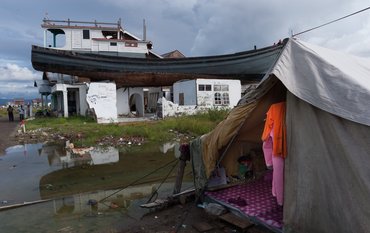The German Research Centre for Geosciences (GFZ) has now received a special award for improving a flood forecasting model: The GFZ's procurement department, together with the project team of the Helmholtz validation project “RIM2D” and the commissioned software development company, have been awarded a prize for their sustainable and innovative procurement approach and its implementation. They have been awarded a Gold Certificate by the Competence Center for Innovative Procurement (“KOINNO”) of the Federal Ministry of Economics and Climate Protection.
How can you make a digital product more sustainable? It's just code. Thomas Unterhofer, IT procurement officer at the GFZ, sums up the answer with a simple comparison: “We have installed an accelerator pedal for computing power.” This allows different computing speeds to be selected in the software, which works with several graphics card chips, depending on the application and urgency.
The flood simulation model not only provides water levels at gauging stations, but also dynamic, high-resolution flood maps. The researchers, Heiko Apel and Julian Haas, have succeeded in linking various forecasting models in such a way that the consequences of a flood can be predicted precisely down to the level of individual buildings. If a local authority or insurance company wants to calculate well in advance what damage a flood could cause, there is little time pressure. The situation is different in the case of an extreme weather situation such as the one on the River Ahr a good three years. Here, RIM2D could be used to simulate a flood forecast for the next 24 hours within just one hour – with correspondingly higher computing power.
The aim of the validation of RIM2D, which is funded by the Helmholtz Association, is to optimize, exploit and improve the applicability of an existing flooding model, which is to be provided as a cloud-computing based service in the future. This means that end users will be able to carry out their computationally intensive simulations in the cloud without expensive acquisition costs for local computing hardware. The use of several simultaneously computing graphics cards (multi-GPU) can drastically reduce the duration of calculations so that even more complex scenarios can be simulated in greater detail.
The project is being implemented together with the software company PERFACCT GmbH. PERFACCT's contract was expanded to include performance-based elements (performance-based contracting), ultimately generating added value for all project partners involved. This had already been part of the tender. The company was given a financial incentive to develop its technology further and thus set itself apart from potential competitors. Part of the requirement was to be able to assess and, if necessary, optimize the energy efficiency of the application through profiling. To this end, the developers used a tool developed by the Potsdam-based company to improve energy management.
Further information:
- https://www.gfz-potsdam.de/en/section/hydrology/projects/rim2d-helmholtz-validation-project
- https://www.koinno-bmwk.de/koinno/praxisbeispiele/ (in German only)
- GFZ news: https://www.gfz-potsdam.de/en/press/news/details/new-approach-for-improved-early-flood-warning
- https://www.rim2d.eu/













![[Translate to English:] [Translate to English:] Abror Gafurov von dem Schriftzug "Welcome to Azerbaijan" und den UN und COP Logos](/fileadmin/_processed_/2/5/csm_2024_11_Baku_COP29_Abror_Gafurov_1042faec82.jpeg)


![[Translate to English:] Martin Herold standing in front of the library on the Telegrafenberg](/fileadmin/_processed_/c/d/csm_Martin_Herold_d385ee4dd9.jpeg)
![[Translate to English:] Many people are listening to a presentation in the GFZ lecture hall.](/fileadmin/_processed_/c/a/csm_1_Bild1_hell_b9c0e9f5ed.jpeg)






![[Translate to English:] Both scientists sitting on stools in front of a wall of books in the Telegrafenberg library](/fileadmin/_processed_/6/6/csm_Buiter_Castell_DORA_4_e87cb1ea18.jpeg)
![[Translate to English:] Gruppenbild mit 4 Personen](/fileadmin/_processed_/8/d/csm_20241017_GFZ-Emmerman-Medal-005_web_reinhardtundsommer_21a414fa4a.jpeg)






![[Translate to English:] Ice landscape with five red tents](/fileadmin/_processed_/8/9/csm_Zeltlager_auf_dem_Eis_Urheberin_Jenine_McCutcheon_5ced2d523b.jpeg)

